Guelaguetza Oaxaca 2024: Your Ultimate Festival Guide
Do you want to experience La Guelaguetza in Oaxaca? Get ready for an immersive cultural experience.
I’ve attended the Guelaguetza Festival twice while living in Oaxaca City. And I can tell you, its reference as La Fiesta Máxima is accurate. The Oaxaca Guelaguetza Festival is the biggest celebration of the year.
Conceived by the Zapotecs over 500 years ago, the name originates from a Zapotec word that roughly translates to “reciprocal exchange of gifts and services.”
Today the Guelaguetza Festival brings together the communities from the eight regions of Oaxaca to share and celebrate their varying traditions of music, dance, art, and food.
I’ve detailed all of the Guelaguetza events below. They begin well before the official start date and continue throughout the month of July.
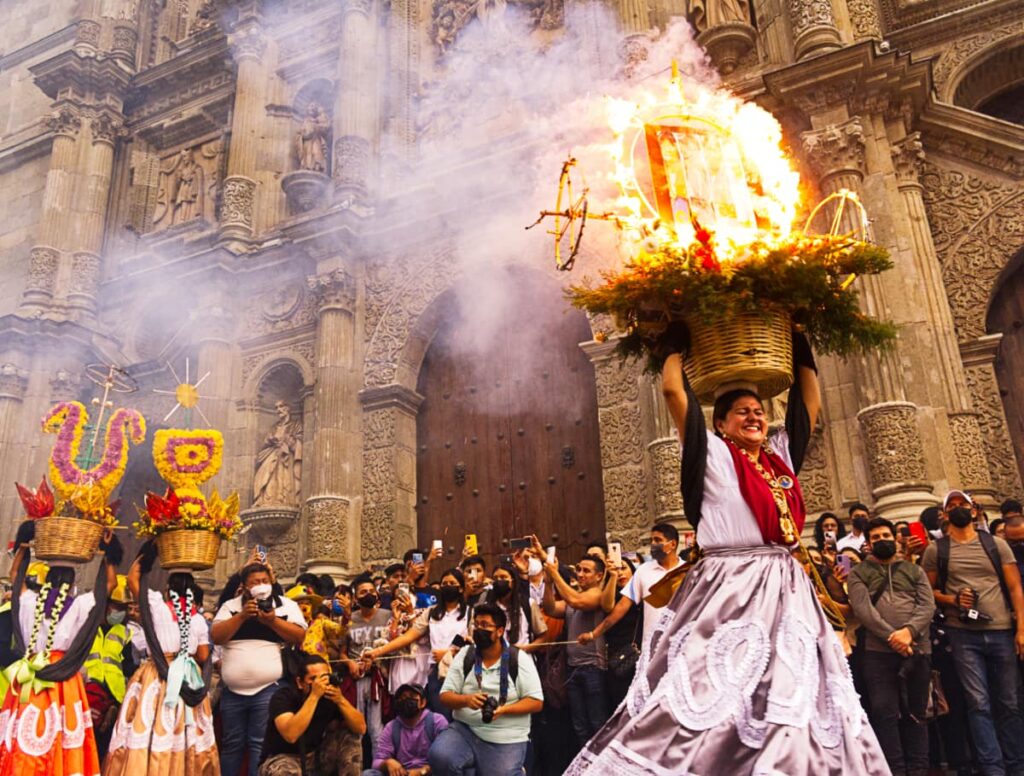
Although it’s crowded, this is an incredible time to be in the city as it celebrates one of the most anticipated festivals in Oaxaca. Guelaguetza events in Oaxaca City alone include numerous concerts, mezcal fairs, food festivals, parades, and much more.
In addition, there are smaller Guelaguetza celebrations in more than 15 pueblos throughout the state of Oaxaca.
If you prefer, you can skip directly to this year’s Guelaguetza events.
This article may contain affiliate links. This means if you click a link on our blog and make a purchase, we earn a commission at no additional cost to you. For full information, please see our disclosure.
Guelaguetza Dates (2024) – When is Guelaguetza in Oaxaca?
Guelaguetza in Oaxaca is celebrated with events throughout the month of July. The festival centers around Los Lunes del Cerro (The Mondays on the Hill) in which there are performances at the Guelaguetza Auditorium.
The dates of Los Lunes del Cerro are the last two Mondays in July. The exception is when the first Monday falls on July 18th which is the official date of Benito Juarez’s death. In that case, La Guelaguetza begins one week later, on the following Monday.
The Guelaguetza 2024 dates are July 22nd and July 29th. Although there are many events preceding the official festival and some events stretch a few days past the second Lunes del Cerro.
Where to Stay for Guelaguetza 2024
I generally recommend travelers book a stay in Oaxaca centro, especially if it’s your first time in the city or you’re visiting during a festival. I’ve included some of my favorite hotels with availability during Guelaguetza below.
El Callejón Hotel ($$$$) – Gorgeous modern suites with an integrated patio filled with tropical plants.
Majagua Hotel ($$$) – Chic boutique hotel with bohemian decor, a downstairs cafe, and a beautiful rooftop.
City Centro Hotel ($$) – Modern hotel with a unique design and a rooftop pool.
Hotel Las Golondrinas ($) – Beautiful rooms in a traditional house with a garden area in a convenient location.
History of La Guelaguetza
Incredibly, the origins of the Guelaguetza Festival in Oaxaca precede the arrival of the Spanish in Mexico. The Zapotecs had an idea to bring different groups together to connect, exchange, and forge relationships. So they developed a celebration in honor of their corn goddess, Xilonen.
When the Aztecs conquered the area, the celebration largely remained the same but they began to worship the Aztec goddess of corn, Centeotl. The arrival of the Spanish added some Christian elements, including the change of date.
Today the Oaxaca Guelaguetza Festival brings together the eight regions of the state which are Cañada, La Costa, Istmo, Mixteca, Papaloapan, Sierra Norte, Sierra Sur, and Valles Centrales.
Guelaguetza Festival Events in Oaxaca City
As the events for Guelaguetza 2024 begin to be announced, I’ll update here. I’ve adjusted these dates based on the previous years. But keep in mind, the exact dates are subject to change.
Please bookmark this page to reference, as I will update the event dates as they are announced.
Events can change at the last moment, it’s important to verify the date, time, and location before you go. With that being said, throughout Oaxaca centro and neighboring towns you can ensure there will be plenty of Guelaguetza events to attend.
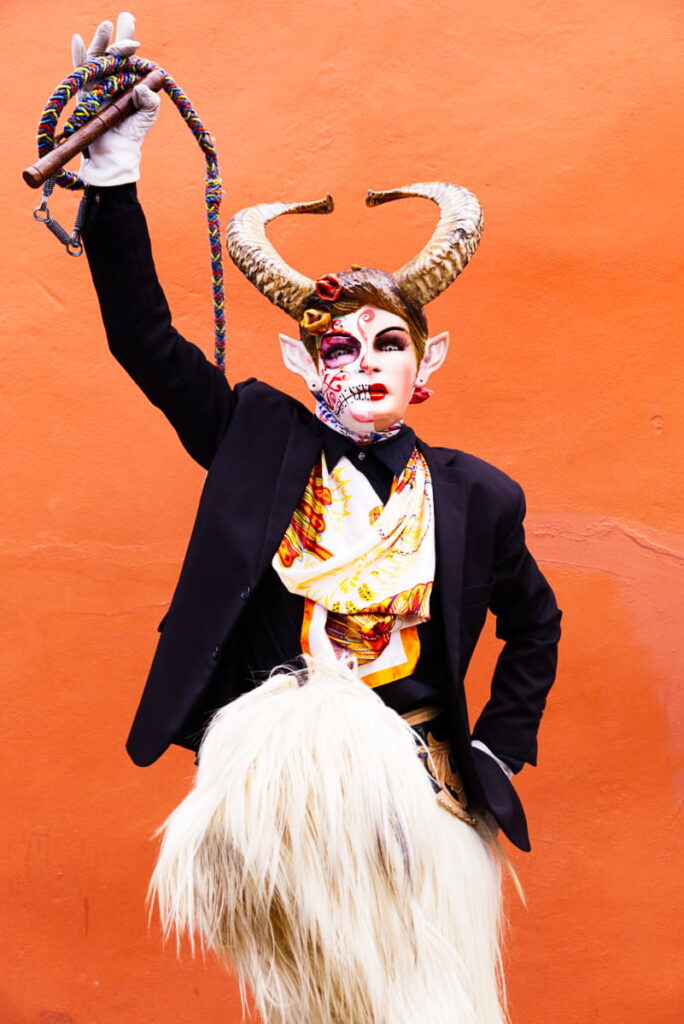
My favorite events of La Guelaguetza in Oaxaca are the parades. They go by different names (convite, desfile, comparsa) depending on the occasion.
Most of the Guelaguetza parades in the city start somewhere around Santo Domingo Church and finish near the Zocalo about two hours later. Although the main parades start in Colonia Reforma, just north of centro and pass by El Llano Park.
TIP – If you’re interested in taking pictures, arrive at the parade about an hour early. There are some nice moments while the groups are waiting for the parade to begin. Often the bands will impromptu play which then inspires the groups to dance. Then find a spot shortly before the parade starts.
Diosa Centéotl – Corn Goddess of the Guelaguetza
Over the course of two nights, more than 40 women contend to become the Diosa Centéotl de la Guelaguetza.
Each woman that steps up to the microphone takes the audience on a journey to their community through sharing their dress, their indigenous language, and their knowledge of their culture.
The beauty being judged is not one of physical appearance, but of the embodiment of culture and tradition.
Every woman is a prominent cultural promoter in their community. Every woman has exceptional knowledge of the traditions, languages, crafts, and customs of their people. Every woman proudly represents the cultures of Oaxaca.
That sense of pride infiltrates the crowd. They are proud of the strong women of Oaxaca. They are proud to be Oaxacan.
And that is what this celebration is all about.
WHEN: June 30th and July 1st at 6 pm
WHERE: Jardin el Panuelito (on the side of Santo Domingo)
Convites – Invitational Parades
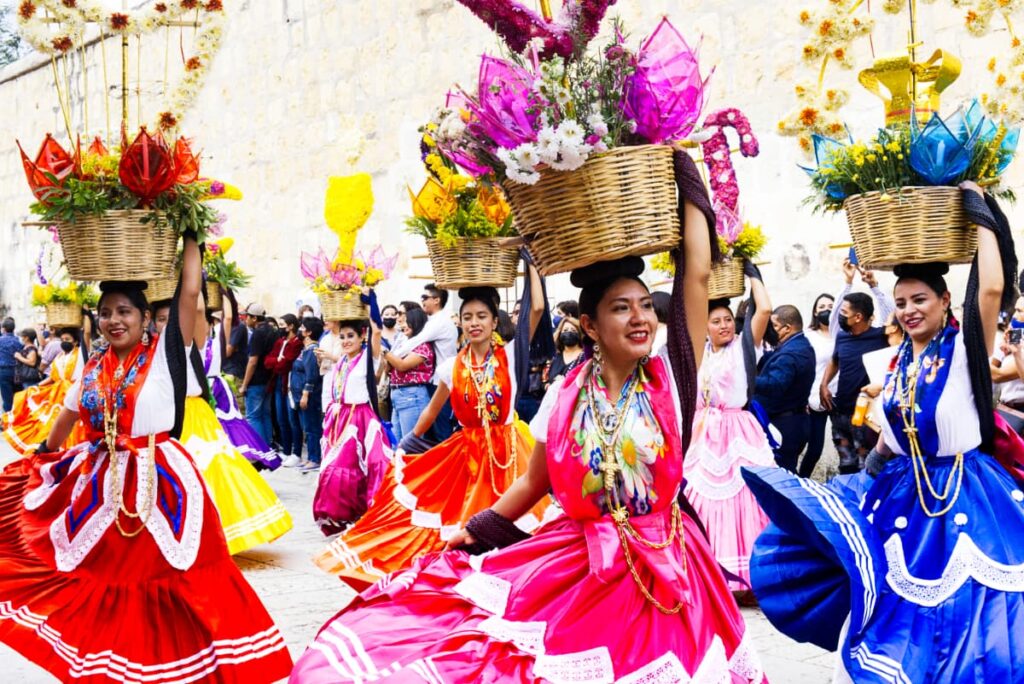
For two consecutive weekends before Los Lunes del Cerro (Mondays on the Hill), the city comes alive with parades, called convites. These parades serve as an announcement and invitation for the upcoming Guelaguetza Festival.
Since Oaxaca and the surrounding Central Valleys are inviting the other regions of the state to participate in the Guelaguetza Festival, the participants of the convites are from central Oaxaca.
You may recognize many of the towns that participate since most are just a short drive from Oaxaca City. They include Mitla, Ocotlán, Teotitlán, Zaachila, Santa Maria Coyotepec, and many more.
WHEN – July 6, 12, 13 at 7 pm
WHERE – Starting at Jardín Carbajal, past Santo Domingo Church, and to the Zocalo
Parade of Delegations – Desfile de Delegaciones
Now that the delegations of Oaxaca have been invited, the Guelaguetza begins, with more parades of course!
This time, the parade participants expand to include communities from throughout the state of Oaxaca. These are the same groups that will perform at the main event, Los Lunes del Cerro, the following Mondays.
WHEN – July 20 and 27, 6 pm
WHERE – Starting at La Fuente de las 8 Regiones, passing El Llano Park, and to the Zocalo
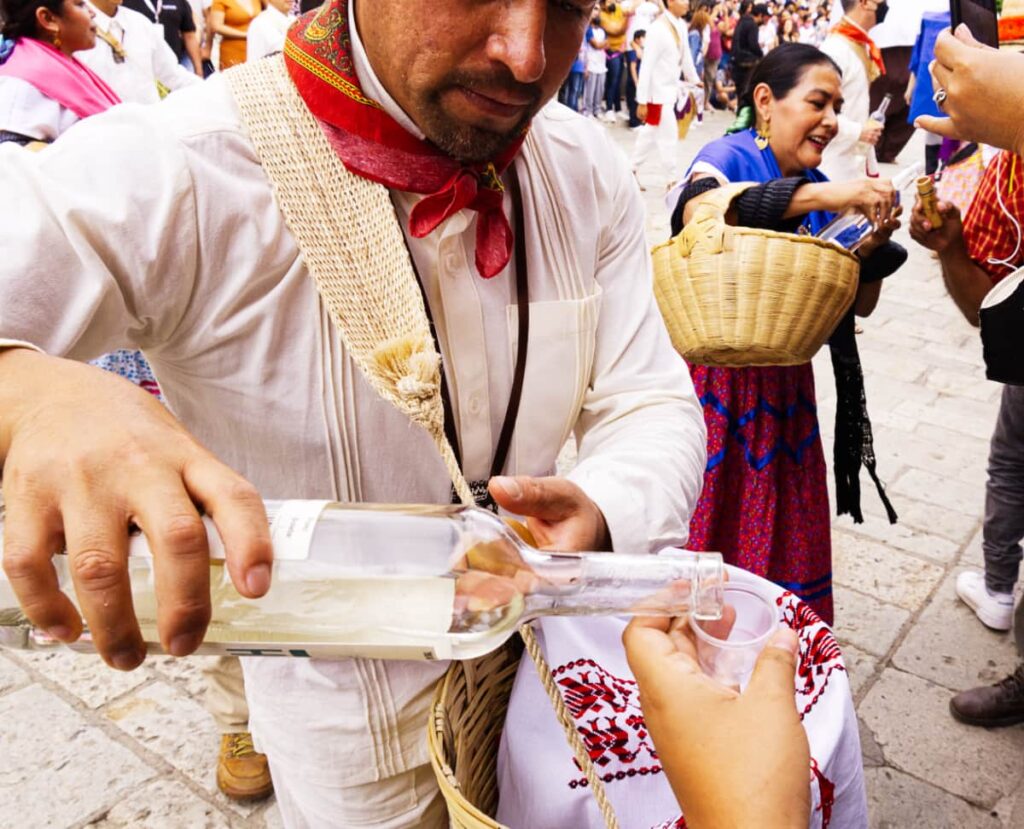
Mondays on the Hill | Lunes del Cerro
Los Lunes del Cerro are the main performances of the festival, held at the Guelaguetza Auditorium which overlooks Oaxaca City. The entire festival centers around these dates.
There are two shows each Monday, one in the morning and one in the evening. At each event, more than 12 communities from the state of Oaxaca perform their traditional dance.
Buying tickets to La Guelaguetza Festival is nearly impossible. The presale of tickets is restricted to those with a Santander bank account. In previous years, both the presale and regular sale of tickets sold out within minutes.
You can also attend the event for free if you’re willing to stand in line for hours on the day of the event. A friend of mine suggests arriving at 3 am to get in line for the 10 am show. Yes, 7 hours of waiting in line.
WHEN – July 22 and 29, 10 am and 5 pm
WHERE – Guelaguetza Auditorium
TICKETS – Purchase online here
Guelaguetza Popular
This event began over 15 years ago with the notion that attending the Guelaguetza in Oaxaca has become commercialized and unattainable for many. The slogan translates to “by the people, for the people.”
It follows a similar format as the main festival, slimmed down to one weekend. It starts with a convite (invitational parade), followed by a parade of the delegations the next day, and finishes with its own Guelaguetza performance on the first Monday of the festival.
WHEN – Parades July 15 and 16 at 3 pm, Guelaguetza July 17 at 9 am
WHERE – Plazuela del Carmen Alto and Oaxaca Technology Stadium
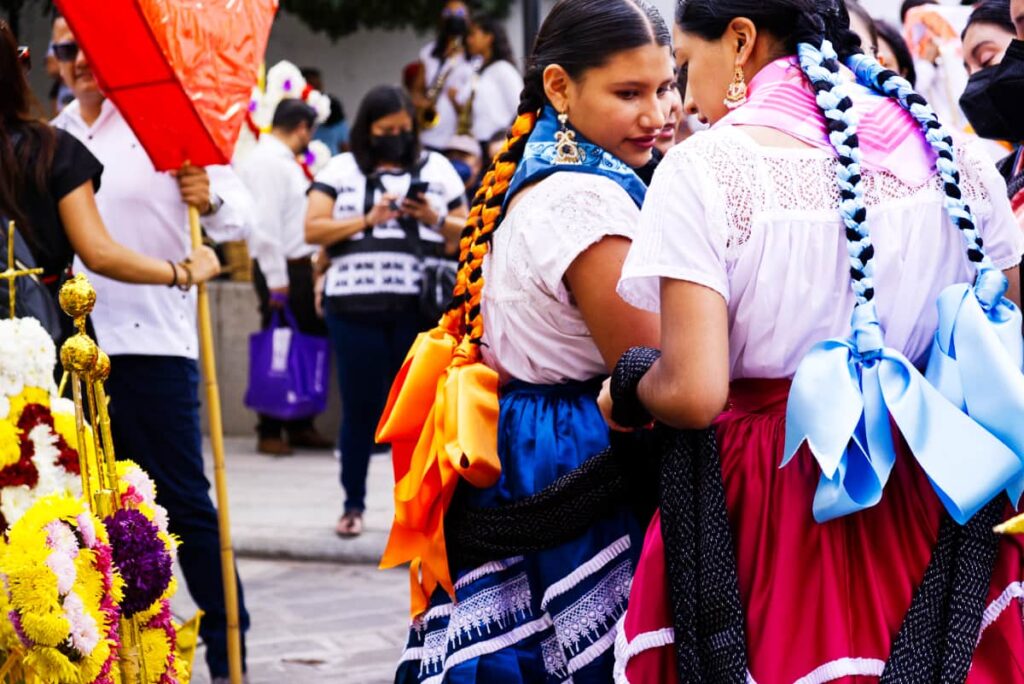
Donají La Leyenda
The story of Donají is a Zapotec legend. It’s a love story between Zapotec Princess, Donají, and a Mixtecan Prince. But it’s also a story of courage and loyalty.
I’m won’t try to tell the story out of fear that I will butcher it. You can read the full legend here (in Spanish) or a short version here. The most beautiful part of the story is about a lily that grew and has since become a symbol for the Zapotec people.
Donají La Leyenda tells the story through a music and dance performance. The event takes place for two consecutive weeks on the Sundays before Los Lunes del Cerro.
WHEN – July 21 and 28, 8:30 pm
WHERE – Guelaguetza Auditorium
TICKETS – You can purchase tickets here
Festival of Moles
Tasting the traditional 7 moles is one of the top things to do in Oaxaca City. At this culinary event, you can taste a variety of moles from the eight regions of Oaxaca.
Tickets need to be purchased in advance. They are available at various restaurants including Tierra del Sol, Las Quince Letras, El Tendajon, Zandunga, and Casa Oaxaca.
WHEN – July 19 at 2 pm
WHERE – Oaxaca Convention Center
Festival of Tejate and Tamales – Feria de Tejate y Tamal
The focus of this event is to taste “the drink of the gods,” a pre-Hispanic drink that blends maize and cacao called tejate.
While it originates from San Andrés Huayapam, it can be found throughout Oaxaca. You may have tasted tejate at one of the markets in Oaxaca. In addition, there will be a tasting of tamales.
You can purchase these specialties from several vendors that will be set up in Plaza de la Danza, one of my favorite outdoor venues in the city.
WHEN – July 24 and 25, 10 am to 7 pm
WHERE – Plaza de la Danza

Ongoing Events for Guelaguetza in Oaxaca City
These Guelaguetza events are ongoing throughout the festival. A couple of these, such as the photography exhibit and the huipil display are things you can plan to see in between other events as you wander around during the Guelaguetza Festival.
Oaxaca Mezcal Fair – Feria Internacional del Mezcal
The Oaxaca Mezcal Fair is one of the most anticipated events of the Guelaguetza. The event showcases over 125 Oaxacan businesses. In addition to mezcal, there are brewers, coffee producers, traditional foods, and artisans.
Before you set off tasting mezcal, make sure to fill your belly with traditional Oaxacan food at the Semana de los Antojos event located in the parking lot. And after, check out the Oaxacan crafts at the Guelaguetza Artisan Fair.
WHEN – July 19 – 30, 10 pm – 10 pm
WHERE – Oaxaca Convention Center
Guelaguetza Photography Exhibition
Delve deeper into the Guelaguetza as you learn about the traditions and dances of the eight regions of Oaxaca.
This presentation is a series of 16 large poster photographs that are displayed in various outdoor venues throughout Oaxaca City. Each poster has a QR code that activates the audiovisual elements.
WHEN – July 13 – 31
WHERE – In front of the government building at the Zocalo (map)
Presentation of Ancestral Huipiles
The huipil is a traditional dress commonly worn by indigenous women throughout much of central Mexico and Guatemala.
Traditional huipiles were woven on a backstrap loom and decorated with embroidery, ribbons, lace, and woven designs. The elements of design vary from community to community which is often an indication of what area the wearer is from.
This ongoing event showcases a variety of ancestral huipiles from throughout the state of Oaxaca.
WHEN – Several weeks throughout the Guelaguetza Festival
WHERE – Archivo Histórico Municipal
Brushstrokes of Tradition – Pinceladas de Tradicion
Located inside the “Alto Coro” room at Hotel Quinta Real, this exhibit showcases the works of all of the artists who competed to create the official image to represent La Guelaguetza.
The winner is announced in early March after a display of the works in the Zocalo in which the public is encouraged to vote for their favorites that advance to the next round.
In 2023, there was a lot of controversy around the contest after the first-place winner was deemed to have copied a photograph by another artist.
WHEN – July 19th – August 2nd from 11 am – 6 pm
WHERE – Hotel Quinta Real Oaxaca
Concerts and Performances – Teatro Macedonio Alcalá
During the month of July, the Macedonia Theater in Oaxaca hosts various events. They include Guelaguetza performances as well as concerts by the Oaxaca symphonic orchestra. You can find out more on their Facebook page.
WHEN – Throughout the month of July
WHERE – Teatro Macedonio Alcalá
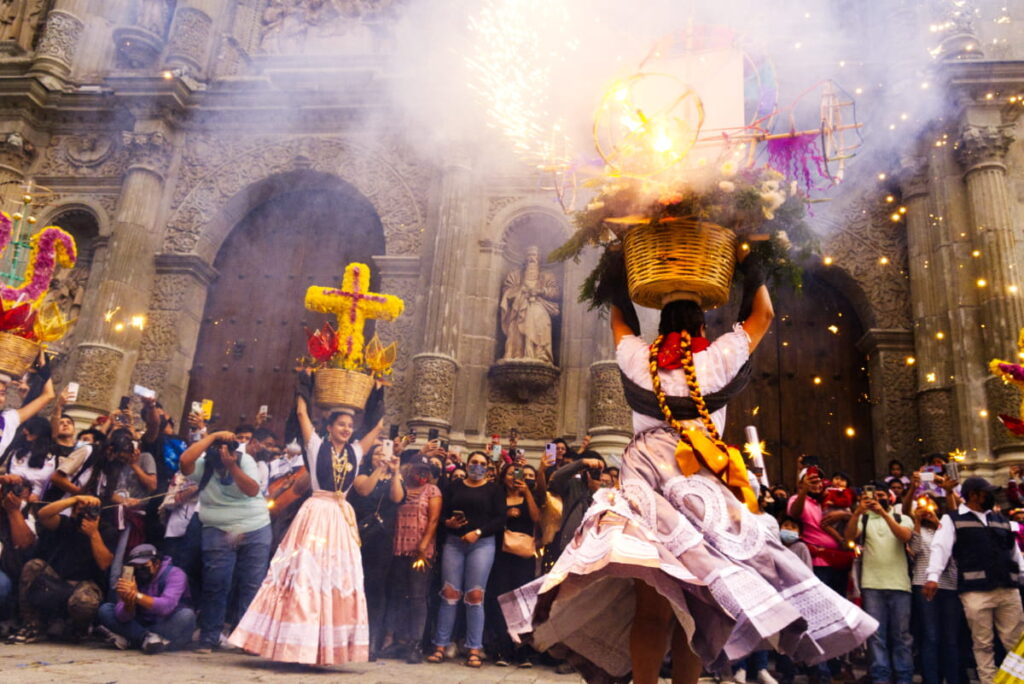
Guelaguetza Events – Oaxaca Central Valleys
Many pueblos in Oaxaca plan events during the month of July to coincide with the festival. Just like the Guelaguetza, they revolve around traditional dances, music, food, artisans, and mezcal.
Some even host their own Guelaguetza Festival that runs simultaneously with the main festival in Oaxaca City. It’s impossible to list (or attend) them all, but below is a variety of events. Most of these are within an hour’s drive of Oaxaca City.
Villa de Zaachila – La Fiesta Grande del Cerrito
Villa de Zaachila is a town with strong Zapotec roots located less than one hour south of the city. So it’s fitting that they would host one of the more exciting Guelaguetza celebrations outside of Oaxaca City.
Weekend events include gastronomic fairs featuring carne asada, barbacoa, mezcal, and artisanal beer. And a couple of workshops – one to learn to make a pre-Hispanic drink, “Chon Ni” and another learning to make sculptures using different colors of corn.
There are also traditional parades and Guelaguetza performances at the archaeological zone of Zaachila, “El Cerrito” located in the center of town.
The events are free, though you can purchase tickets to the main event at El Cerrito if you prefer to have seats in front of the stage.
WHEN – July 20 – 29, El Cerrito July 29th at 1 pm
WHERE – Zaachila (40 min south of the city)
San Pablo Villa de Mitla – Feria de Mezcal y La Guelaguetza
The events in Mitla throughout the week of La Guelaguetza include a mezcal tasting, an agave workshop, a demonstration of waist loom weaving, and a guayabera exhibition.
In addition, on the two Sundays before Mondays on the Hill, there is an afternoon parade followed by a Guelaguetza performance. You can find the schedule on their Facebook page.
WHEN – July 20 – 29
WHERE – Mitla (50 min east of the city)
Ocotlán de Morelos – Fiesta de Hermandad, Cultura, y Tradición
For the Guelaguetza, Ocotlán hosts a festival of brotherhood, culture, and tradition. The events include an artisan expo, a mezcal fair, and concerts.
On the Mondays of the festival, there is a parade in the afternoon followed by a Guelaguetza performance in Los Sabinos Park. You can find the full schedule on their Facebook page.
WHEN – July 22 – 29
WHERE – Ocotlán (1 hour south of the city)
San Jacinto Amilpas, Oaxaca Guelaguetza
The Sunday before the main festival begins, San Jacinto Amilpas hosts a mini Guelaguetza Festival. The celebration begins with a food fair, followed by a parade, and ends with a performance at the main sports complex.
The event is free and the parade participants include multiple delegations from the state of Oaxaca.
WHEN – July 21, Food Fair at 9:30 am, Parade at 4 pm, Guelaguetza at 5:30 pm
WHERE – San Jacinto Amilpas (20 min northwest of the city)
Danza de la Pluma – Encuentro de Danzas
Experience one of the most famous dances of Oaxaca at this meeting of the dances.
Cuilápan de Guerrero is having its own Guelaguetza celebrations but I want to highlight this event specifically.
This traditional dance features a semi-circular headpiece made up of over 3,000 colored feathers. It’s then decorated with various sized mirrors which represent the moon and stars.
La Danza de la Pluma will be performed by the communities of Zaachila, San Bartolo Coyotepec, Teotitlán del Valle, and Cuilápam.
WHEN – July 23 at 4 pm
WHERE – Cuilapan de Guerrero (30 min south of the city)
Tlayuda Festival – San Antonio de la Cal
San Antonio de la Cal is considered the birthplace of the tlayuda, a signature Oaxacan food.
Visitors will be able to learn all about the tlayuda from preparing the corn dough for the large tortilla used as the base to cooking the tlayuda on the comal.
For the festival, over a dozen women set up their tlayuda stand in the square in front of the church in San Antonio de la Cal.
WHEN – July 23 – 29 from 10 am – 10 pm
WHERE – San Antonio de la Cal (20 min south of the city)
La Gran Fiesta de Mezcal – Santiago Matatlán
It’s only fitting for the town titled the “World Capital of Mezcal,” to host its own mezcal fair for La Guelaguetza.
Santiago Matatlán produces an average of 40% of the mezcal in all of Mexico. So in an effort to shine a light on the traditions of their mezcaleros, they have organized The Great Mezcal Party.
The event includes musical and dance performances, horse races, bull riding, and of course, mezcal demonstrations and tastings. You can find out more on their Instagram.
WHEN – July 29 – August 3 from 12 pm – 8 pm
WHERE – Santiago Matatlán (1 hour east of the city)
Red Pottery Fair – San Marcos Tlapazola
On the weekend before Guelaguetza begins, the town of San Marcos Tlapazola invites visitors to learn about their tradition of red pottery.
The event includes guided visits of the pottery workshops as well as clay demonstrations. There is of course traditional food and other cultural events as well.
WHEN – July 12 – 14 from 10 am – 6 pm
WHERE – San Marcos Tlapazola (1 hour east of the city)
Alebrije Fair – San Martín Tilcajete
The small town of San Martín Tilcajete is known for the fanatical animals carved of copal wood and painted with intricate designs, called alebrijes.
This is an opportunity to see the works of many artists at once while wandering the booths set up in the center of the town.
While you’re there, plan to visit an alebrije workshop which is included on my favorite day trips from Oaxaca.
WHEN – July 10 – 31 from 9 am – 6 pm
WHERE – San Martín Tilcajete (1 hour south of the city)
Artisan Fair – Tlacolula de Matamoros
This artisan fair in Tlacolula de Matamoros features textiles, traditional shoes, filagree jewelry, baskets, and more. It’s located in the center of this small town.
If you can, try to go on a Sunday to explore the Tlacolula Market, one of the oldest markets in Oaxaca.
WHEN – July 20, 21, 27, 28 from 10 am – 6 pm
WHERE – Tlacolula (1 hour east of the city)
Final Thoughts About La Guelaguetza, Oaxaca
Whew! You can see why they call it “La Fiesta Máxima!”
It’s impossible to see even half of these Guelaguetza events. My advice is to narrow it down to just a few so that you can actually enjoy the Guelaguetza Festival.
It’s a great opportunity to absorb the culture of Oaxaca whether you’re watching a parade through the streets or one of the more formal presentations.
Both give an opportunity to see traditional dances from different regions of the state such as Flor de Pina, Danza de la Pluma, Jarabe Ejuteco, and more. As well as taste the incredibly rich and varied cuisine of Oaxaca.

